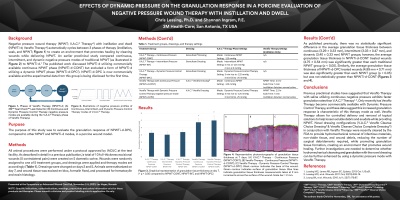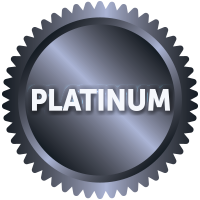Laboratory Research
(LR-013) Effects of dynamic pressure on the granulation response in a porcine evaluation of negative pressure wound therapy with instillation and dwell

Shannon Ingram, BS, PE – Laboratory Director, 3M Health Care
Introduction: Negative pressure wound therapy with instillation and dwell (NPWTi-d) automatically cycles between 3 phases of therapy (instillation, dwell, and negative pressure) to create an environment that promotes healing by cleaning wounds while delivering NPWT. An early preclinical study compared continuous, intermittent, and dynamic negative pressure modes of traditional NPWT to NPWTi-d.1 The published work discussed NPWTi-d utilizing commercially available continuous NPWT phase (NPWTi-d-CONT) but excluded a non-commercial form of NPWTi-d utilizing a dynamic NPWT phase (NPWTi-d-DPC) included in the experiment. NPWTi-d-DPC is now commercially available and the experimental data from this group is being disclosed for the first time.
Methods: Full-thickness excisional wounds were created in a porcine model and treated for 7 days with dressing changes on days 2 and 5 as described in a previous publication1. There were five treatment groups total: three NPWT treatment groups (continuous, intermittent, and dynamic NPWT); and two treatment groups of NPWTi-d with saline (NPWTi-d-CONT and NPWTi-d-DPC). Wound specimens were harvested for histology on day 7.
Results: As published previously, there was no statistically significant difference in average granulation tissue thickness between continuous (3.29 ± 0.33 mm), intermittent (3.03 ± 0.47 mm), and dynamic (3.40 ± 0.33 mm) NPWT groups; however, granulation tissue thickness in NPWTi-d-CONT treated wounds (4.75 ± 0.54 mm) was significantly greater than each traditional NPWT groups (p < 0.05)1. Similarly, average granulation tissue thickness of NPWTi-d-DPC treated wounds (4.99 mm ± 0.71 mm) was also significantly greater than each NPWT group (p < 0.05) but was not statistically different from NPWTi-d-CONT.
Discussion: Only recently has NPWTi-d become commercially available with a dynamic NPWT phase. Although not confirmed in humans, the data suggest wounds treated with NPWTi-d-CONT or NPWTi-d-DPC with saline instillation may exhibit faster granulation rates than wounds treated with traditional NPWT. Additionally, NPWTi-d allows controlled solution exposure to help loosen soluble debris and exudate. Ultimately, further investigations are needed to understand the impact of NPWTi-d-CONT and NPWTi-d-DPC on wound cleansing and granulation.
Trademarked Items: 3M™ Veraflo™ Therapy
References: 1. Lessing MC, James RB, Ingram SC. Eplasty. 2013 Oct 1;13:e51.
Methods: Full-thickness excisional wounds were created in a porcine model and treated for 7 days with dressing changes on days 2 and 5 as described in a previous publication1. There were five treatment groups total: three NPWT treatment groups (continuous, intermittent, and dynamic NPWT); and two treatment groups of NPWTi-d with saline (NPWTi-d-CONT and NPWTi-d-DPC). Wound specimens were harvested for histology on day 7.
Results: As published previously, there was no statistically significant difference in average granulation tissue thickness between continuous (3.29 ± 0.33 mm), intermittent (3.03 ± 0.47 mm), and dynamic (3.40 ± 0.33 mm) NPWT groups; however, granulation tissue thickness in NPWTi-d-CONT treated wounds (4.75 ± 0.54 mm) was significantly greater than each traditional NPWT groups (p < 0.05)1. Similarly, average granulation tissue thickness of NPWTi-d-DPC treated wounds (4.99 mm ± 0.71 mm) was also significantly greater than each NPWT group (p < 0.05) but was not statistically different from NPWTi-d-CONT.
Discussion: Only recently has NPWTi-d become commercially available with a dynamic NPWT phase. Although not confirmed in humans, the data suggest wounds treated with NPWTi-d-CONT or NPWTi-d-DPC with saline instillation may exhibit faster granulation rates than wounds treated with traditional NPWT. Additionally, NPWTi-d allows controlled solution exposure to help loosen soluble debris and exudate. Ultimately, further investigations are needed to understand the impact of NPWTi-d-CONT and NPWTi-d-DPC on wound cleansing and granulation.
Trademarked Items: 3M™ Veraflo™ Therapy
References: 1. Lessing MC, James RB, Ingram SC. Eplasty. 2013 Oct 1;13:e51.

.png)
